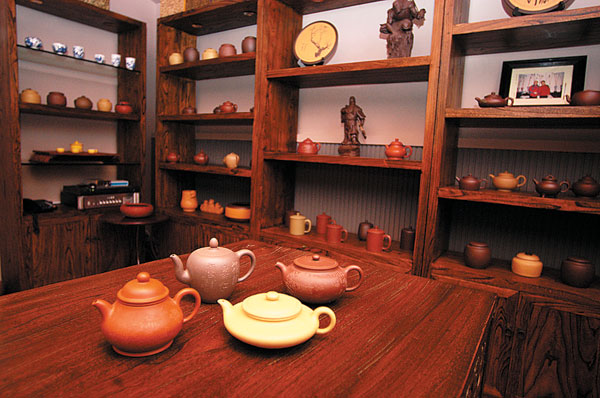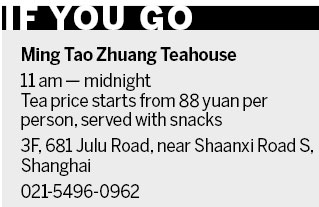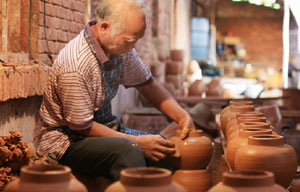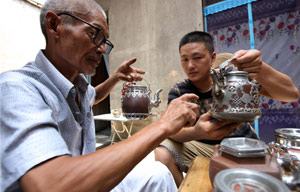Precious pots make good cuppa
Updated: 2013-08-19 14:19
By Zhang Kun in Shanghai (China Daily)
|
|||||||||||
 |
|
Zhou Wei / China Daily |
Yixing clay might be the most expensive mud in the world. A Yixing clay teapot sold for more than 12 million yuan ($1.96 million) at a Beijing auction in 2010.
Zhang Changying, a connoisseur of "zisha" (purple sand), the Chinese name of Yixing clay, readily shares his knowledge from decades spent handling these teapots. His new teahouse, Ming Tao Zhuang, just celebrated its grand opening.
The teahouse doesn't open until almost noon, and guests linger until late at night, enjoying tea from fine ceramics and an exhibition of Yixing teapots.
All the teapots look much the same to untrained eyes - no more than 10 to 15 centimeters in height and diameter, of dark non-glossy surface, with a matching cap on top and mouth on the side.

A handmade zisha pot may sell for a few hundred or thousands of yuan, Zhang says. Souvenir pots can be purchased for 20 to 100 yuan, but Zhang says it is unlikely to be handmade or of pure purple sand. Quality of the clay, the handicraft, artists involved and so on, all play a part in determining the price of a Yixing clay teapot.
"It embodies the essence of Chinese art," Zhang says.
Yixing is a city in Jiangsu province, which has been part of the Yangtze Delta. Silt from the river mixed with endemic algae formed a unique type of rock. Yixing clay is made by grinding and weathering these rocks. "There are mines of it - people have been digging the clay in the same way they mine coal," Zhang explains. Yixing clay has three basic tones of color: purple, red and green. Whichever tone it is, the clay is mostly dark and unglazed, not glossy and shining bright like porcelain.
Artists and intellectuals were involved in making teapots from the 15th century. They composed poems, created paintings and printed personal seals on the pots. Copycat and counterfeit teapots accompanied the development of the handicraft from the very beginning, Zhang adds.
"The fine aesthetics of old-time intellectuals emphasized the restraint and subtlety of the purple sand. They would have their own pots tailor made, with original calligraphy, paintings and seals added."
Yixing clay is baked at lower temperature than porcelain. It is unglazed, or in Zhang's word, "breathable". The teapot absorbs a small amount of the tea as it brewed inside. Sometimes the user will have a pot for each type of tea, to maintain the consistency of the flavor.
In recent decades, Yixing clay teapots have risen rapidly in value.
In the early 1980s as China started to open up to the world, buyers from Taiwan first flocked to Yixing.
Many of the teapots are sold to Taiwan and Southeast Asia.
The pot with the record breaking price auctioned by Jiade Auction House in 2010, was made by Gu Jingzhou (1915-1996). Now Gu's students and their students are the top craftsmen in the field.
Craftsmen reach the pinnacle of their career in their 50s, as their eyesight often loses the sharpness after this and they then pass the knowledge of the craft on to the next generation of the family.
|
|
|
| Pottery craft a dying art |
Related Stories
Inheriting traditional tin pot technique 2013-08-01 13:50
A feast for the eyes, not the stomach 2013-08-18 07:52
Purely artistic 2013-08-18 07:49
Many pieces to make a whole 2013-08-18 07:49
Confucius comes to life as a man 2013-08-17 10:29
An artist's self-discovery in Tibet 2013-08-16 10:27
Today's Top News
Be innovative, Premier Li tells graduates
Beijing, Moscow cooperate on floods
New info in Diana's death
Egypt: 36 prisoners killed in violence
Onus on US to improve military ties
Home price rises slow in July
Trustee council may be answer for reforming
40 killed as floods ravage NE China
Hot Topics
Lunar probe , China growth forecasts, Emission rules get tougher, China seen through 'colored lens', International board,
Editor's Picks

|

|

|

|

|

|







